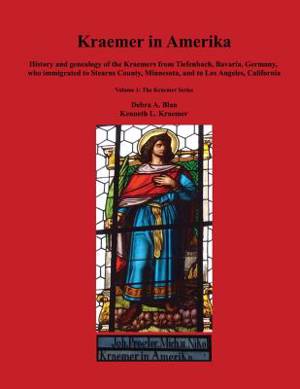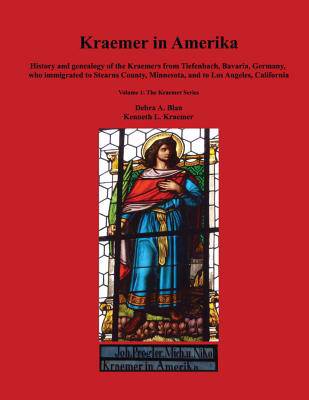
- Retrait gratuit dans votre magasin Club
- 7.000.000 titres dans notre catalogue
- Payer en toute sécurité
- Toujours un magasin près de chez vous
- Retrait gratuit dans votre magasin Club
- 7.000.000 titres dans notre catalogue
- Payer en toute sécurité
- Toujours un magasin près de chez vous
Kraemer in Amerika
History and genealogy of the Kraemers from Tiefenbach, Bavaria, Germany, who immigrated to Stearns County, Minnesota, and to Los Angeles, California
Kenneth L Kraemer, Debra a Blau
52,45 €
+ 104 points
Description
The authors stumbled upon an unsolved mystery far away in the homeland of their ancestors, in a small village named Tiefenbach, set among the beautiful rolling hills in the Oberpfalz region of eastern Bavaria, Germany. The mystery involved a unique stained-glass church window with an intriguing inscription, "Kraemer in Amerika." Setting out to discover the meaning behind the inscription, the authors found themselves faced with many unanswered questions: * Who did "Kraemer in Amerika" represent? * Where in America did this Kraemer live? * Who donated money for the Kraemer window? * In what year was the window inscribed? * Could there be a fascinating story behind the donation? Research in Germany led to the discovery of several Kraemer families who lived in the Catholic parish of Tiefenbach. One of these Kraemers, namely Paul (the great-great-grandfather of author Ken Kraemer), worked as a weaver in the nearby village of Irlach. Paul left Irlach in 1866 and eventually settled on a farm in Wisconsin. Some of his descendants, the "Wisconsin Kraemers," established prosperous construction and road building firms in Sauk County, Wisconsin. The authors were astounded to find out that another Kraemer had ties to America! Paul's distant cousin, Michael Kraemer, worked as a tobacco maker in Tiefenbach, and had three married sons who immigrated to America as early as 1852. Could the three brothers in this line of Kraemers provide the missing piece of the puzzle of the stained-glass window? The three brothers were some of the early rugged pioneers in Stearns County, Minnesota. The oldest brother, named after his father, Michael, was a kindhearted Minnesotan whom everyone called "Papa." He created a town, built a Catholic church in the name of his wife, and left a legacy of multiple Century Farms, businesses, and descendants in the state. The middle brother named George experienced the worst kind of grief when he lost three of his children in the 1881 smallpox epidemic, which affected nearly every family in Stearns County, including the family of his brother Michael. George never fully recovered from the tragedy. Nikolaus, the youngest of these brothers, started out as a cigar manufacturer in St. Cloud, Minnesota, in 1862, then later uprooted his family to Los Angeles, California; his eldest child remained in St. Cloud. This distinguished bearded Californian left a legacy through his five beautiful and talented daughters and a son, and became modestly wealthy in the 1890s land boom in LA. In 1900, an unexplainable tragedy befell the family. The daughters survived through successful marriages and bonds of sisterhood on ranches in rural Los Angeles. This book reveals the identity of the "Kraemer in Amerika" mystery, and details the struggles, tragedies, and ultimate triumph in the new world of the "Minnesota Kraemers." The authors have filled the chapters with family history, original documents, and family photos, along with an extensive index of names, places and occupations.
Spécifications
Parties prenantes
- Auteur(s) :
- Editeur:
Contenu
- Nombre de pages :
- 344
- Langue:
- Anglais
- Collection :
- Tome:
- n° 1
Caractéristiques
- EAN:
- 9781500764975
- Date de parution :
- 21-08-14
- Format:
- Livre broché
- Format numérique:
- Trade paperback (VS)
- Dimensions :
- 216 mm x 279 mm
- Poids :
- 798 g







